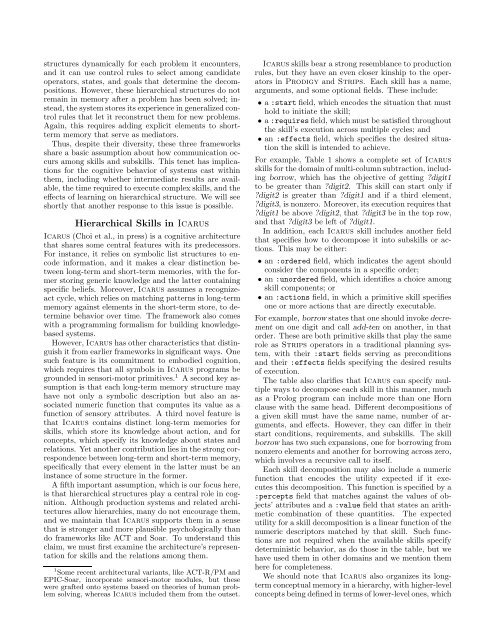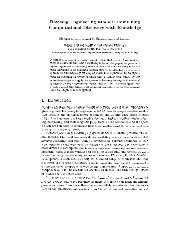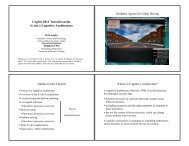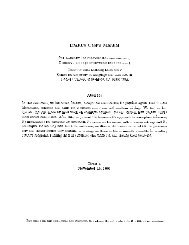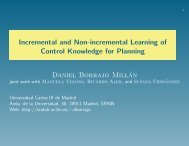Hierarchical Skills and Cognitive Architectures - Computational ...
Hierarchical Skills and Cognitive Architectures - Computational ...
Hierarchical Skills and Cognitive Architectures - Computational ...
Create successful ePaper yourself
Turn your PDF publications into a flip-book with our unique Google optimized e-Paper software.
structures dynamically for each problem it encounters,<br />
<strong>and</strong> it can use control rules to select among c<strong>and</strong>idate<br />
operators, states, <strong>and</strong> goals that determine the decompositions.<br />
However, these hierarchical structures do not<br />
remain in memory after a problem has been solved; instead,<br />
the system stores its experience in generalized control<br />
rules that let it reconstruct them for new problems.<br />
Again, this requires adding explicit elements to shortterm<br />
memory that serve as mediators.<br />
Thus, despite their diversity, these three frameworks<br />
share a basic assumption about how communication occurs<br />
among skills <strong>and</strong> subskills. This tenet has implications<br />
for the cognitive behavior of systems cast within<br />
them, including whether intermediate results are available,<br />
the time required to execute complex skills, <strong>and</strong> the<br />
effects of learning on hierarchical structure. We will see<br />
shortly that another response to this issue is possible.<br />
<strong>Hierarchical</strong> <strong>Skills</strong> in Icarus<br />
Icarus (Choi et al., in press) is a cognitive architecture<br />
that shares some central features with its predecessors.<br />
For instance, it relies on symbolic list structures to encode<br />
information, <strong>and</strong> it makes a clear distinction between<br />
long-term <strong>and</strong> short-term memories, with the former<br />
storing generic knowledge <strong>and</strong> the latter containing<br />
specific beliefs. Moreover, Icarus assumes a recognizeact<br />
cycle, which relies on matching patterns in long-term<br />
memory against elements in the short-term store, to determine<br />
behavior over time. The framework also comes<br />
with a programming formalism for building knowledgebased<br />
systems.<br />
However, Icarus has other characteristics that distinguish<br />
it from earlier frameworks in significant ways. One<br />
such feature is its commitment to embodied cognition,<br />
which requires that all symbols in Icarus programs be<br />
grounded in sensori-motor primitives. 1 A second key assumption<br />
is that each long-term memory structure may<br />
have not only a symbolic description but also an associated<br />
numeric function that computes its value as a<br />
function of sensory attributes. A third novel feature is<br />
that Icarus contains distinct long-term memories for<br />
skills, which store its knowledge about action, <strong>and</strong> for<br />
concepts, which specify its knowledge about states <strong>and</strong><br />
relations. Yet another contribution lies in the strong correspondence<br />
between long-term <strong>and</strong> short-term memory,<br />
specifically that every element in the latter must be an<br />
instance of some structure in the former.<br />
A fifth important assumption, which is our focus here,<br />
is that hierarchical structures play a central role in cognition.<br />
Although production systems <strong>and</strong> related architectures<br />
allow hierarchies, many do not encourage them,<br />
<strong>and</strong> we maintain that Icarus supports them in a sense<br />
that is stronger <strong>and</strong> more plausible psychologically than<br />
do frameworks like ACT <strong>and</strong> Soar. To underst<strong>and</strong> this<br />
claim, we must first examine the architecture’s representation<br />
for skills <strong>and</strong> the relations among them.<br />
1 Some recent architectural variants, like ACT-R/PM <strong>and</strong><br />
EPIC-Soar, incorporate sensori-motor modules, but these<br />
were grafted onto systems based on theories of human problem<br />
solving, whereas Icarus included them from the outset.<br />
Icarus skills bear a strong resemblance to production<br />
rules, but they have an even closer kinship to the operators<br />
in Prodigy <strong>and</strong> Strips. Each skill has a name,<br />
arguments, <strong>and</strong> some optional fields. These include:<br />
• a :start field, which encodes the situation that must<br />
hold to initiate the skill;<br />
• a:requires field, which must be satisfied throughout<br />
the skill’s execution across multiple cycles; <strong>and</strong><br />
• an :effects field, which specifies the desired situation<br />
the skill is intended to achieve.<br />
For example, Table 1 shows a complete set of Icarus<br />
skills for the domain of multi-column subtraction, including<br />
borrow, which has the objective of getting ?digit1<br />
to be greater than ?digit2. This skill can start only if<br />
?digit2 is greater than ?digit1 <strong>and</strong> if a third element,<br />
?digit3, is nonzero. Moreover, its execution requires that<br />
?digit1 be above ?digit2, that ?digit3 be in the top row,<br />
<strong>and</strong> that ?digit3 be left of ?digit1.<br />
In addition, each Icarus skill includes another field<br />
that specifies how to decompose it into subskills or actions.<br />
This may be either:<br />
• an :ordered field, which indicates the agent should<br />
consider the components in a specific order;<br />
• an :unordered field, which identifies a choice among<br />
skill components; or<br />
• an :actions field, in which a primitive skill specifies<br />
one or more actions that are directly executable.<br />
For example, borrow states that one should invoke decrement<br />
on one digit <strong>and</strong> call add-ten on another, in that<br />
order. These are both primitive skills that play the same<br />
role as Strips operators in a traditional planning system,<br />
with their :start fields serving as preconditions<br />
<strong>and</strong> their :effects fields specifying the desired results<br />
of execution.<br />
The table also clarifies that Icarus can specify multiple<br />
ways to decompose each skill in this manner, much<br />
as a Prolog program can include more than one Horn<br />
clause with the same head. Different decompositions of<br />
a given skill must have the same name, number of arguments,<br />
<strong>and</strong> effects. However, they can differ in their<br />
start conditions, requirements, <strong>and</strong> subskills. The skill<br />
borrow has two such expansions, one for borrowing from<br />
nonzero elements <strong>and</strong> another for borrowing across zero,<br />
which involves a recursive call to itself.<br />
Each skill decomposition may also include a numeric<br />
function that encodes the utility expected if it executes<br />
this decomposition. This function is specified by a<br />
:percepts field that matches against the values of objects’<br />
attributes <strong>and</strong> a :value field that states an arithmetic<br />
combination of these quantities. The expected<br />
utility for a skill decomposition is a linear function of the<br />
numeric descriptors matched by that skill. Such functions<br />
are not required when the available skills specify<br />
deterministic behavior, as do those in the table, but we<br />
have used them in other domains <strong>and</strong> we mention them<br />
here for completeness.<br />
We should note that Icarus also organizes its longterm<br />
conceptual memory in a hierarchy, with higher-level<br />
concepts being defined in terms of lower-level ones, which


